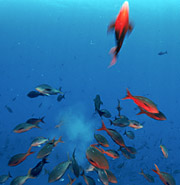![[Ocean Oasis Field Guide]](images/bnr-oo-field.gif)

![[Ocean Oasis Field Guide]](images/bnr-oo-field.gif) |  |
|
Paranthias colonus Family: SERRANIDAE (Groupers and sea basses) |
|
DescriptionA salmon-red color, deeply forked tail, and four or five light spots on the back distinguish adults. Juveniles are pinkish-yellow, with bright blue dorsal spots. They grow in length to at least 35.6 cm (14 inches). Range and HabitatPacific creolefish are commonly found from the Central Gulf of California to Peru, usually around reefs and rock faces. They form large mid-water schools to depths of about 61 meters (200 feet). Natural HistoryOne of the most abundant fish in the Gulf of California and Revillagigedo Islands, creolefish occur in large groups, usually in currents where they feed on plankton. They are very important for the reef ecosystem, as their fecal matter contains a large quantity of carbon compounds that are utilized by small fishes and invertebrates, thus contributing to the energy efficiency of reef communities. During spring and early summer creolefish gather to reproduce. The Creolefish are broadcast spawners. Milt and eggs burst into the water, and mix right into the water column. Schools of mackerel and other fish dash in to feast, but many eggs survive, and the young appear by the end of spring. This is a different reproductive strategy than that of other fish—like the sergeant major—which produce fewer eggs but tend them carefully. Both strategies have proven to be effective reproductive techniques. Barberfish and the juveniles of Mexican hogfish act as cleaner-fish and remove ectoparasites from the adults. |

This scene from the film, Ocean Oasis, shows the creolefish broadcasting a cloud of eggs and milt into the water. |
Text by Patricia Beller
Photograph from Ocean Oasis © 2000 CinemaCorp of the Californias
Field Guide |
Site Index |
Ocean Oasis Introduction
|
|
© 2000 San Diego Natural History Museum |